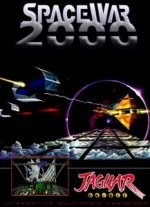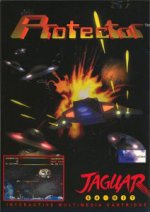Website Temporary Closed
Atari Jaguar
The Atari Jaguar is was introduced in November 1993 as a powerful next generation platform. It was infamously touted as the "first 64-bit system". Competing with Sega and Nintendo's 16-bit consoles, the Jaguar was said to be 64-bit. Back then, "bitness" was an important marketing factor in the gaming industry, just as polygon-pushing power is today. The Jaguar did not work off of a solitary 64-bit processor, but instead had a collection of processors with bus widths ranging from 16 to 64 bits. The bit classification of the Jaguar is still a source of considerable debate today. Consensus exists among those who are familiar with the system hardware that, because Jaguar's main data bus and some of the processors are 64-bit, the entire system can be considered 64 bit. It would otherwise be considered a 32-bit console.
Nonetheless, it was technically superior to the leading 16-bit consoles at the time. Unfortunately, this last ditch effort by Atari to find room in the console market failed. A relatively small number of games were developed for the system, but Atari pulled the plug altogether in 1996. The Jaguar was a minor cult success. Jaguar conventions are held to show off rare unfinished Jaguar games that never made it to the shelves. A development company named Songbird Productions still produces games available for sale on the commercial market.
[collapse collapsed title=read more...]
The Jaguar and the Lynx were the last two Atari systems to be developed, but because the company did not want any direct involvement in hardware production, they were produced by outside contractors. In 1990, Flare Technology, a company formed by Martin Brennan and John Mathieson with Atari funding, said that not only could they make a console far superior to the Sega Genesis or the SNES, but they could also be cost-effective. Atari immediately agreed and the system was released in November 1993 for a sale price of $249.99, under a $500 million manufacturing deal with IBM. The system was initially marketed only in the New York City and the San Francisco Bay areas. A nationwide release followed in early 1994.
The system was marketed under the slogan "Do the Math" (i.e. 32 bit + 32 bit = 64 bit), claiming superiority over competing 16-bit systems. Initially, the system sold well, substantially outselling the highly hyped and publicized 3DO, which was also released during the holiday season of 1993. However, the system was eventually considered a failure, due to a perception of the Jaguar having poor games and an overall lack of software developed. The system was difficult to program for as the hardware had a large number of bugs, including one in the memory controller that stopped some of its processors executing code from the system RAM.
The final nail in the coffin was the release of both the Sony PlayStation in Fall 1995 and the Sega Saturn earlier in the summer. In an interview, Sam Tramiel, CEO of Atari, also touted that the Jaguar was much more powerful than the Saturn and slightly weaker than the PlayStation. He also predicted the price of the PlayStation to be $500 and said that any price from $250 to $300 would be dumping and that Atari would sue to block sales (they never did). The baseless comments were selected as #3 in the Top 25 Dumbest Moments in Gaming.
In a last ditch effort to rescue the Jaguar, Atari tried to play down these two consoles by claiming the Jaguar was the only 64-bit system, causing some controversy. (Some contended that the Jaguar's two 64-bit "processors" were essentially nothing more than graphics accelerators; its GPU was only 32-bit and its CPU was a 16-bit 68000.) This advertising push was futile, and production of the Jaguar stopped after Atari purchased JT Storage in a reverse takeover.
Several peripherals were announced, such as a voice modem and VR headset, but the only peripherals released were the Atari Jaguar CD drive and the JagLink, a simple two-console networking device. Working prototypes of some of the proposed future developments exist (some, such as the Jaguar Voice Modem, in relatively large quantities), and include fully-functional versions of the VR headset, with infrared head-tracking, and a stereo adaptor to allow connection of the Jaguar to a hi-fi system. See Loki and Konix Multisystem for early development.
After Atari was bought out by Hasbro Interactive in the late 1990s, Hasbro released the encryption coding to the Jaguar, finally opening the doors for enthusiasts and hobby programmers to make their own Jaguar games and software, similar to what has happened with another defunct game system, the Sega Dreamcast. Several game companies, including Telegames and Songbird Productions, have not only released previously unfinished materials from the Jaguar's past, but also several brand new titles to satisfy the system's cult following.
[/collapse]
- HOME


- PRODUCTS

- 3DO
- Amiga CD32
- Amstrad GX4000
- Atari 2600
- Atari 7800
- Atari Jaguar
- Atari Jaguar CD
- Atari Lynx
- Bandai Wonderswan
- Coleco
- Colecovision
- Famicom
- Famicom Disk System
- Grandstand
- JAMMA
- Mattel Intellivision
- MB
- Microsoft Xbox
- MSX
- Neo Geo AES
- Neo Geo CD
- Neo Geo MVS
- Neo Geo Pocket
- Nintendo 64
- Nintendo Game and Watch
- Nintendo Gameboy
- Nintendo Gameboy Advance
- Nintendo Gameboy Colour
- Nintendo Gamecube
- Nintendo NES
- Nintendo Virtual Boy
- PC Engine
- PC Engine CD
- Philips CDI
- Sega 32X
- Sega Dreamcast
- Sega Game Gear
- Sega Genesis
- Sega Master System
- Sega Mega CD
- Sega Megadrive
- Sega Nomad
- Sega Saturn
- Sony Playstation
- Sony Playstation 2
- Super Famicom
- Super Nintendo
- Texas Instruments
- Tiger Game Com
- Tomy
- Vectrex
- Japanese Video Game Imports
-

- MODIFICATIONS

- Switchless Modification
- Modification Sega 32X
- Modification Sega Dreamcast
- Modification Sega Megadrive
- Modification Neo Geo AES
- Modification Neo Geo CD
- Modification Nintendo NES
- Modification Sega Master System
- Modification Sega Mega-CD
- Modification Sega Nomad
- Modification Sega Saturn
- Modification Super Nintendo
-

- TECHNICAL INFO


- NEWS


- ABOUT US


- MEMBERS


- CONTACT US


Log on
x
Just In!












 Save time
Save time